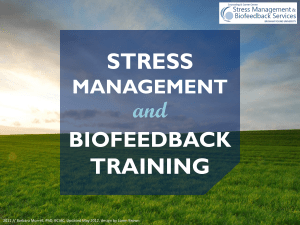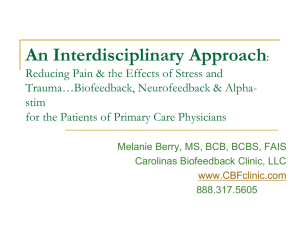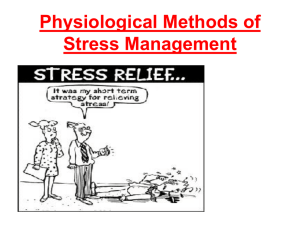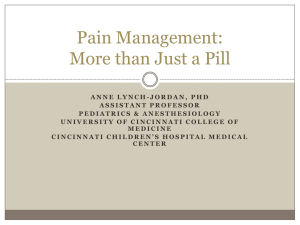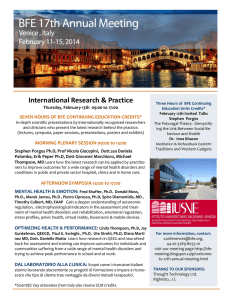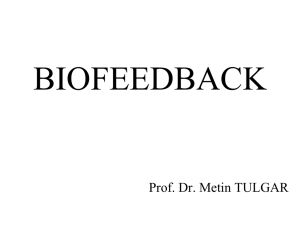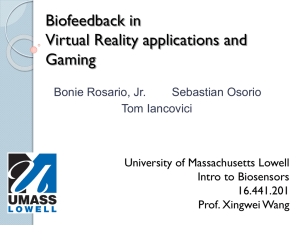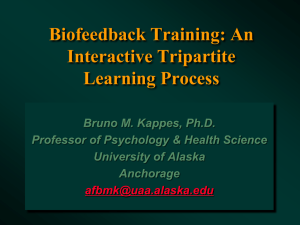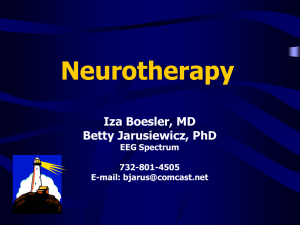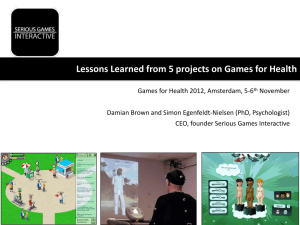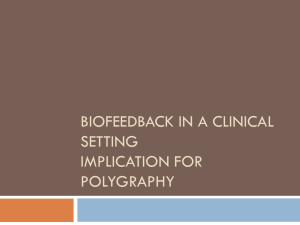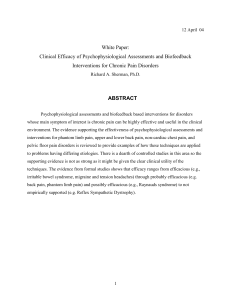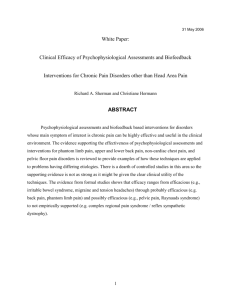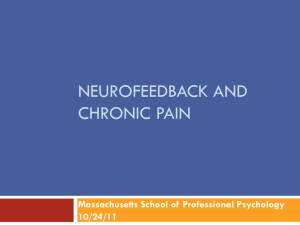Biofeedback-Managing Chronic Pain -Anthony
advertisement
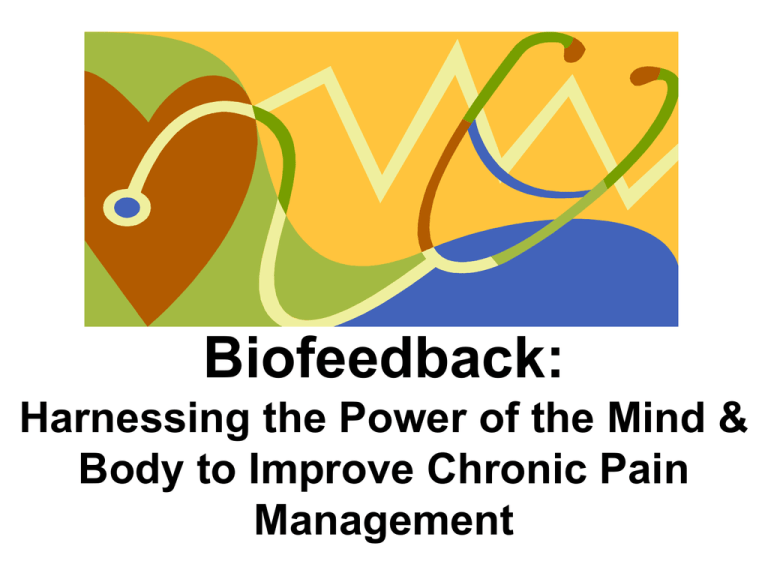
Biofeedback: Harnessing the Power of the Mind & Body to Improve Chronic Pain Management Disclosure: • Nothing to disclose ANTHONY WHITNEY, MS, LMHC, BCB Behavioral Therapist Licensed Mental Health Counselor Board Certified in General Biofeedback St. Luke’s Rehabilitation Institute 711 South Cowley St. Suite 310 Spokane, WA 99202 (509) 473-6942 Whitnea@st-lukes.org Objectives: • Acquaint the audience with the benefits of integrating mind and body based treatment modalities to increase an individual’s internal locus of control and recovery. • Describe biofeedback techniques that are incorporated in the treatment of chronic pain to increase functioning and quality of life. • Identify and analyze potential warning signs frequently associated with the development of pain disorders. • A brief but detailed demonstration of one or more biofeedback modalities will be completed. 3-Legged Stool of Health & Well-Being • Pharmaceuticals • Surgery • Diet, Exercise, Stress Management, Psychology, Biofeedback, etc. Chronic Pain • The International Association for the Study of Pain (IASP) defines pain as “an unpleasant sensory and emotional experience associated with actual or potential tissue damage” *1 • Chronic pain is a unique to the individual – The same issues, symptoms or findings can cause significant chronic pain in one individual, and little or none in another • Chronic pain includes both sensory and emotional experiences *1 Classification of Chronic Pain, Second Edition, IASP Internal vs. External Locus of Control • People who base their success on their own work and believe they control their life have an internal locus of control.*2 • In contrast, people who attribute their success or failure to outside influences have an external locus of control.*2 *2 http://education-portal.com/academy/lesson/locus-of-control-definition-andexamples-of-internal-and-external.html#lesson Mind-Body Connection • Each person is unique • We need to remind ourselves that pain is a symptom and does not define the person • Most individuals need to rebuild/recreate their sense of identity • As long as the mind and body are disconnected or in conflict healing is limited or at a stand still Biofeedback/Behavioral Therapy BIOFEEDBACK DEFINITION The following definition has been approved by: • Association for Applied Psychophysiology and Biofeedback (AAPB) • Biofeedback Certification International Alliance (BCIA) • International Society for Neurofeedback and Research (ISNR) *3 http://www.aapb.org/ BIOFEEDBACK: • Is a process that enables an individual to learn how to change physiological activity for the purposes of improving health and performance. Precise instruments measure physiological activity such as brainwaves, heart function, breathing, muscle activity, and skin temperature. (Cont.) *3 Biofeedback Definition Cont. • These instruments rapidly and accurately "feed back" information to the user. The presentation of this information - often in conjunction with changes in thinking, emotions, and behavior -supports desired physiological changes. Over time, these changes can endure without continued use of an instrument. *3 Biofeedback/Behavioral Therapy • Individuals learn to make behavioral changes to increase desirable responses and improve their physical, emotional and mental health • Educational with the focus on increasing the individual’s internal locus of control and reducing the unknown • Develop a home program to work toward life changes Biofeedback & Chronic Pain • Creates a window into the body/brain and provides objective data • Allows both the person receiving biofeedback and the therapist awareness of: • The body’s functional state: i.e. stressed, tensed, relaxed, abnormal, symmetry • Real time changes in the body: muscle tension, brain waves, heart rate variability, temperature, etc. • Changes are tracked over time Biofeedback & Chronic Pain • Used to increase the person’s body and mind awareness • Increased awareness can allow the person to make immediate adjustments striving for optimal results Biofeedback & Chronic Pain • Facilitate an increased internal locus of control • Decrease the unknown • Develop self-sufficient coping skills and auto-regulation What Biofeedback Does Not Do • Provide independent medical or psychological diagnoses • Using biofeedback equipment only is not an optimum treatment • It does not measure or show pain • It is not a stand alone curative treatment • It does not cause change Keys to Success: • When engaging in Mind-Body based treatment such as biofeedback it is important to aid the individual in identifying and progressing through the following six stages of recovery: EXAMINE RECOGNIZE RESPONSIBILITY CHANGE ACCEPT COMMIT Biofeedback Techniques • • • • • • Respiration Training Surface Electromyography (sEMG): Galvanic Skin Response (GSR) Skin Temperature Electroencephalogram (EEG) Blood Volume Pulse (BVP): • Heart Rate, Heart Rate Variability (HRV) & Blood flow Respiration Biofeedback • Respiratory Belt: Applied to mid-chest and/or abdomen • Respirations are under both voluntary and involuntary control. Surface Electromyography (sEMG) • sEMG biofeedback is most often used in the treatment of musculoskeletal movement and chronic pain http://drepabst.com/site/faqs/ Dr. Eugénie Pabst, Psy.D. Galvanic Skin Response (GSR) • GSR monitors your stress levels by translating tiny tension-related changes in skin pores • The individual learns to decrease or increase the feedback and thus decrease stress levels or increase energy levels Skin Temperature • Temperature biofeedback empowers the individual to learn to increase and/or decrease blood flow into the extremities to facilitate healing and self-regulation Electroencephalogram (EEG): AKA - Neurofeedback • Neurofeedback (NFB), also called neurotherapy or neurobiofeedback, is a type of biofeedback that uses real-time displays of electroencephalogram (EEG) or hemoencephalography (HEG) to illustrate brain activity and teach selfregulation. *4 BREATHING! Linda Causey 2011, www.aperfectworld.org Breathing Rate: • Average 12 breaths per minute (B/M) • 20-24 B/M: Early stages of hyperventilation • 10<: Beginning of therapeutic benefits • 6 + or – 1: resonant frequency & increased heart rate variability Breathing Like Keys? Even the smallest difference is important! Breathing Demonstration Pain Disorder Warning Signs Red Flags • Consistently high pain complaints • Pain complaints that get worse with time • Discontinues physical therapy because it causes too much pain • High level of narcotic use • Family stress, separation, divorce • Substance abuse (alcohol, drug, Rx) Pain Disorder Warning Signs Red Flags • Consistently high pain complaints • Pain complaints that get worse with time • Discontinues physical therapy because it causes too much pain • High level of narcotic use • Family stress, separation, divorce • Substance abuse (alcohol, drug, Rx) MEDICATIONS Red Flags • • • • Limited activity level. High levels of anger Frequent pain behaviors Overly solicitous or protective family members • Strong focus on finding out what is wrong or on being fixed • Doctor shopping Red Flags • History of trauma or abuse • Job dissatisfaction • Family members who are disabled or receiving benefits from L&I or SSI. • Legal involvement. • Lack of social support Working With Individuals Who Have Chronic Pain • Attempt to start by meeting the person where he or she is at and then assist them with change • A good provider/patient relationship is essential for a successful outcome • Remember to track/measure changes – This is just as important, if not more, for the person struggling with chronic pain to do Working With Cont. • Think multidisciplinary –Explore referral options –Build active communication within the treatment team Finding A Quality Biofeedback Specialist • Recommend seeking providers who are certified by the Biofeedback Certification International Alliance (BCIA) • The website has a “find a practitioner” tool that searches the globe: – For a specific provider – By country, state or x-miles within a zip code • http://www.bcia.org Biofeedback Demonstration sEMG of Bilateral Upper Trapezuis Muscles Shrug Flex. Rest AB/AD Relax Rest Relax-2 Rest Rest Post Assessment Shrug Flex. AB/AD Cued to “Relax” Relax REFERENCES: 1. "Part III: Pain Terms, A Current List with Definitions and Notes on Usage" (pp 209-214) Classification of Chronic Pain, Second Edition, IASP Task Force on Taxonomy, edited by H. Merskey and N. Bogduk, IASP Press, Seattle, ©1994. 2. Education Portal. Available at: http://educationportal.com/academy/lesson/locus-of-control-definition-andexamples-of-internal-and-external.html#lesson /. Accessed May 17, 2014. 3. Dictionary.com. relaxation. (n.d.). The American Heritage® Stedman's Medical Dictionary. http://dictionary.reference.com/browse/relaxation. Accessed May 17, 2014. 4. Wikipedia. Neurofeedback. Wikimedia Foundation, Inc. Available at: http://en.wikipedia.org/wiki/Neurofeedback. Accessed May 18, 2014.
